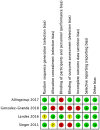Is Energy Delivery Guided by Indirect Calorimetry Associated With Improved Clinical Outcomes in Critically Ill Patients? A Systematic Review and Meta-analysis
- PMID: 32231435
- PMCID: PMC7082874
- DOI: 10.1177/1178638820903295
Is Energy Delivery Guided by Indirect Calorimetry Associated With Improved Clinical Outcomes in Critically Ill Patients? A Systematic Review and Meta-analysis
Abstract
Background: Indirect calorimetry (IC) is recommended to guide energy delivery over predictive equations in critical illness due to its precision. However, the impact of using IC to measure energy expenditure on clinical outcomes is uncertain.
Objective: To evaluate whether using IC to measure energy expenditure to inform energy delivery reduced hospital mortality and improved other important outcomes compared to using predictive equations in critically ill adults.
Methods: A systematic literature review was conducted following the Preferred Reporting Items for Systematic Reviews and Meta-analyses guideline. Medline, Embase, CINAHL, and the Cochrane Library were searched for studies using IC to guide energy delivery compared to a predictive equation in adult critically ill patients with the primary outcome (hospital mortality) or any of the secondary outcomes reported (including but not limited to hospital and intensive care unit (ICU) length of stay (LOS) and duration mechanical ventilation (MV). Risk of bias within studies was assessed using the Cochrane "Risk of Bias" 1 tool. Random-effect meta-analyses were used when heterogeneity between studies existed (I2 > 50%). Data are reported as median (interquartile range [IQR]), binomial outcomes as odds ratio (OR), 95% confidence interval (CI), and continuous outcomes as mean difference (MD).
Results: Of 4060 articles, 4 randomized controlled trials were identified with 396 patients included in analysis. Three studies were considered low risk of bias and 1 as high risk. Two studies reported hospital mortality (n = 130 and 40 participants, respectively). When combined, no association between IC-guided energy delivery and hospital mortality was found (OR = 0.81, 95% CI = [0.25, 2.67], P = 0.73, I2 = 52). No differences were reported with ICU mortality and hospital LOS between groups, but ICU LOS and duration of MV varied across all studies. According to the meta-analysis, no differences were observed in ICU LOS (MD = 1.39, 95% CI = [-5.01, 7.79], P = 0.67, I2 = 81%), although the duration of MV was increased when energy delivery was guided by IC (MD = 2.01, 95% CI = [0.45, 3.57], P = 0.01, I2 = 26%). In all 4 studies, prescribed energy targets were more closely met when energy delivery was informed by IC compared to a predictive equation. Three studies reported the percentage delivered versus the prescribed energy target, with the median (IQR) delta between the IC and predictive equation arms 19% (10%-32%).
Conclusion: Limited data exist to assess the impact of using IC to inform energy delivery in comparison to predictive equations on hospital mortality. The association of IC use with other important outcomes, including duration of MV, needs to be further explored before definitive conclusions can be made.
Keywords: Critical illness; energy expenditure; indirect calorimetry; meta-analysis; predictive equations; systematic literature review.
© The Author(s) 2020.
Conflict of interest statement
Declaration of conflicting interests:The author(s) declared no potential conflicts of interest with respect to the research, authorship, and/or publication of this article.
Figures




References
-
- Walker RN, Heuberger RA. Predictive equations for energy needs for the critically ill. Respir Care. 2009;54:509-521. - PubMed
-
- Tatucu-Babet OA, Ridley EJ, Tierney AC. Prevalence of underprescription or overprescription of energy needs in critically ill mechanically ventilated adults as determined by indirect calorimetry: a systematic literature review. JPEN J Parenter Enteral Nutr. 2016;40:212-225. - PubMed
-
- Zusman O, Kagan I, Bendavid I, Theilla M, Cohen J, Singer P. Predictive equations versus measured energy expenditure by indirect calorimetry: a retrospective validation. Clin Nutr. 2019;38:1206-1210. - PubMed
-
- Singer P, Blaser AR, Berger MM, et al. ESPEN guideline on clinical nutrition in the intensive care unit. Clin Nutr. 2019;38:48-79. - PubMed
LinkOut - more resources
Full Text Sources
Miscellaneous

